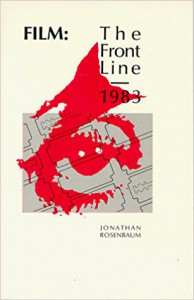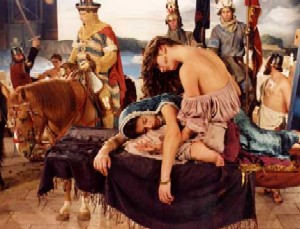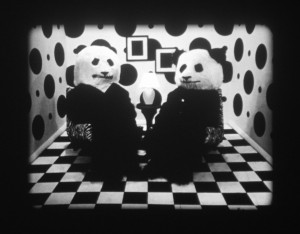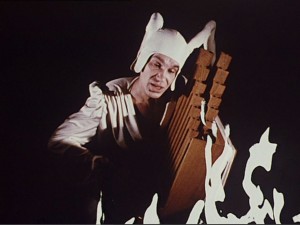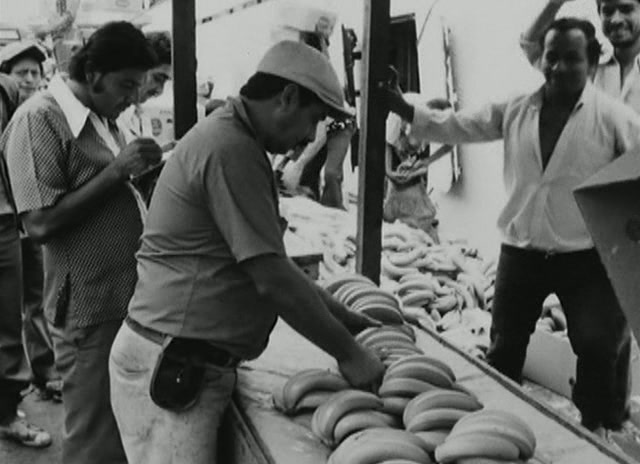My book Film: The Front Line 1983 (Denver: Arden Press), intended by its editor-publisher to launch an annual series, regrettably lasted for only one other volume, by David Ehrenstein, after two other commissioned authors failed to submit completed manuscripts. Miraculously, however, this book remained in print for roughly 35 years, and now that it’s finally reached the end of that run (although some copies can still be found online), I’ve decided to reproduce more of its contents on this site, along with links and (when available) illustrations. I’m beginning with the book’s end, an Appendix subtitled “22 More Filmmakers,” which I’m posting here in three installments, along with links and (when available) illustrations. — J.R.
PAULA GLADSTONE. In Gladstone’s mainly black-and-white, hour-long, Super-8 The Dancing Soul of the Walking People (1978), possession and. dispossession both happily become very much beside the point. Shot over a two-year period, 1974-1976, each time the filmmaker went home to Coney Island (“I’d take my camera out and walk from one end of the land to the other,” she reports in Camera Obscura [No. 6]; “I’d talk to people on the streets and film them”), The Dancing Soul of the Walking People is basically concerned with the space underneath a boardwalk, a little bit like the luminous insides of a translucent zebra on a sunny day — an interesting kind of space, at once public and private, that is traversed by receding strips of light, camera pans, and people, in fairly continuous processions and/or rhythmic patterns. Playing against these traversals is the repeated sound of galloping hoofs, some lyrical jazz arrangements (Duke Ellington with a scat singer, George Russell, Anthony Braxton, Stravinsky’s Firebird rearranged by Alice Coltrane), “Under the Boardwalk” by The Drifters, conversation about Coney Island, and some funky black-and male-oriented poetry, written and read by Gladstone — more material, in short, that’s merely passing through.
Harp glissandos seem to go directly with the mottled stripes, and the kind of visual drift that characterizes most of the film can turn into a kind of ecstatic contemplation when it focuses on two little boys tossing up clouds of sand — magical emanations that are partially separated by jump cuts. It’s nice to see how Gladstone, like those kids, can be structural and non-possessive at the same time.
JEAN-LUC GODARD is as major an omission as I can imagine, largely necessitated by the philistinism of a country that isn’t even interested in his prodigious work for French TV. (The little that I’ve seen, particularly of the second series done for French TV, France tour détour deux enfants, surpasses any recent American programming about anything that comes to mind. The British Film Institute owns videotapes of both of Godard’s series, and has even gone to the trouble of having them translated for classroom purposes. But the much wealthier American Film Institute apparently couldn’t care less.) Regarding Passion, his last feature — which Chantal Akerman told me was the most exciting film by anyone she’s seen in years — we’ll have to wait until Godard agrees to let the film be shown in the U.S.; it’s already had some commercial runs in Europe.
And what about GEORGE LANDOW, a particular favorite as well? Three years ago, Soho News commissioned a piece from me entitled “Getting Ready for Landow” (May 28, 1980) —specifically, in preparation for the New York premiere of his 1979 film, On the Marriage Broker Joke as Cited by Sigmund Freud in Wit and Its Relation to the Unconscious, or Can the Avant-Garde Artist Be Wholed? But such are the contradictions of being a non-wholed journalist that I had to miss the film’s actual premiere (at the Collective for Living Cinema on June 6), and haven’t been able to catch up with it since. In the meantime, I can only recommend Institutional Quality (1969), Remedial Reading Comprehension (1971), Wide Angle Saxon, and New Improved Institutional Quality: In the Environment of Liquids and Nasals a Parasitic Vowel Sometimes Develops (both 1975). These movies get their well-earned howls (and titles) by starting from the structural nightmares imposed by different forms of institutional rhetoric — childhood perception tests, TV ads and newscasters, speed-reading techniques, and even structural films (when Landow parodies himself, Snow, Frampton, and Sitney).
I’ve seen only one film by ROSE LOWDER, and it is mentioned elsewhere in this book — both in the section on Peter Gidal and in the conversation with Gidal that comes at the end. Lowder has been making films only since 1978, and Retour d’un repère composé (Composed Recurrence), made in 1981 and 59 minutes long, was shot in a single day, frame by frame, using a rotational system in which seven separate focus points where chosen. The setting filmed is a tree branch by a duck pond which Lowder has mentioned having looked at for years — it was where she sat and had coffee — before she thought of making the film. The original length of what she shot, comprising 60 separate bits of film, was 21/2 seconds; the complex system of repetition in the film, as in many of Gidal’s films, is not experienced as repetition. As Lowder explains in her program notes, “The same material is presented successively in three versions: a simple single print, a double print printed slightly differently twice onto the same piece of film stock, a triple print printed slightly differently thrice likewise, each version providing a configuration of rhythm of its own.” Born in Peru of British parents, and presently living in Avignon where she moved from London, Lowder in a way seems as elusive to a precise nationality as Gidal or Straub. She sees her film as “a vehicle to go somewhere else” (as she put it at Millennium Film Workshop on November 20, 1982), not as “a beautiful object.” Yet insofar as she focuses for an hour on the same subject and processes, one can certainly find aspects of beauty in the experience of watching it. At times the colors seem to function like musical phrases that mix and thicken, growing sumptuous in spots that made me think of Berlioz. But this rich diet of rushing images eventually begins to take on a reef-like underwater appearance, emphasized by the oscillation between sharpness and blurriness in separate images. Process eventually overtakes everything, so that the images become more and more decomposed, and the very notion of surface seems to become undermined. If there’s a more rigorous film of this kind available anywhere, I don’t know what it is.
PAUL MORRISSEY would not ordinarily belong on this list, were it not for the remarkable film version of Forty Deuce (1982), which as I write has yet to receive a public screening anywhere in this country, to my knowledge. (I caught it at the Toronto Festival of Festivals.) Morrissey’s starting point is a brilliant literary construction, a play by Alan Bowne written in a mainly invented male hustler lingo, set around 42nd Street. Simply as a theatrical object, the writing has the kind of giddy power that makes Wallace Shawn’s dramatic monologues, in My Dinner with Andre and elsewhere, seem to have all the combined finesse and corrosiveness of a Mickey Spillane by comparison. (Shawn’s lackluster use of profanity in his plays was desperately succeeded by the vastly more successful, “cleaner” Andre, directed by Louis Malle — a film of some local historical moment insofar as it confirms with an audible sigh of relief that the true aims of the American art film are petit-bourgeois, a conclusion arrived at independently by Allen, Cimino, and Mazursky. Needless to say, this gospel was accepted with as much dutiful glee in The New Yorker as the patriarchal, macho Zeus stances of Brakhage and Coppola are unproblematically savored in The Village Voice.)
Aiming at something more nearly Elizabethan than New Yorkerish in style as well as at moral nuance, Bowne’s play has some of the lyrical urban rage of Jack Gelber’s The Connection (with the related theme of heroin addiction); but the passion that went into the jazz improvisations there are conveyed here directly through Bowne’s remarkable poetic language, in which obscenities are mounted and relished like jewels in the midst of other verbal exotica. Shirley Clarke’s film of The Connection attempted unsuccessfully to deconstruct its own filmic terms much as the play had sought to undo certain theater conventions. Morrissey’s film adopts the unexpected course of opening up the play’s first half into long, loping takes across substantial portions of the title street and the adjacent Port Authority Bus Terminal, then compulsively closing in the second half — set mainly in one cramped hotel room — even further by filming all the action with adjacent cameras, and showing this double-action in simultaneous split-screen. The variable binocular effect of the latter has led to the charge of arbitrariness in some quarters, yet it seems a defensible as well as daring formal approximation of a vision that sees the whole world through a veil of cross-eyed and two-faced duplicity — a context where every act has at least two motives and hence potential cross-purposes, and every event becomes at once a moment of moral horror and an act of aesthetic perception. Triumphantly sui generis, Forty Deuce is said by Morrissey to have been influenced by Gance’s Napoléon as well as Sartre’s No Exit. Yet its rhythms, intonations and vocal colors — not to mention its intoxicating language — could not be more American.
Having already written at some length about and with great affection for the deliberately primitive and rather Jarryesque work of LUC MOULLET (see my article/position-paper in the November-December 1977 Film Comment), I want to mention him here only to point out that he’s managed to remain active in recent years, although none of his movies since Anatomy of a Relationship (1975) have made it across the Atlantic. I’ve heard about at least three more completed Moullet films, all described favorably to me by various friends and acquaintances who’ve seen them in Paris): Origins of a Meal, a documentary about the sources of the ingredients in a meal; an autobiographical documentary of intermediate length (i.e., a featurette, like Driver’s You Are Not I) about Moullet in his forties learning how to swim; and an episode for a French TV series about the change of government after the election of Mitterand—a series to which Godard and Jean-Louis Comolli, among others, also contributed episodes. (Godard, one hears, created something of a scandal by having himself stripped and beaten in his own segment.)

